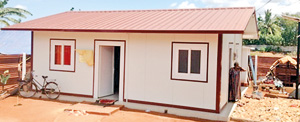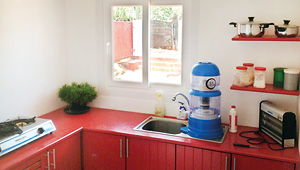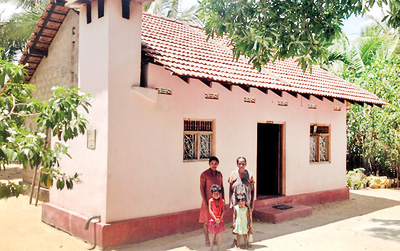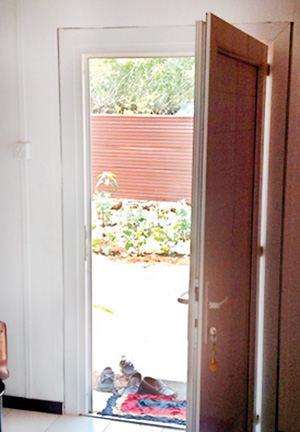Sunday Times 2
65,000 houses: A socio-cultural emancipation or a welfare disaster in the making?
Much has been said and written about the 65,000 houses programme being proposed by the Government. Its critics claim it to be an improperly conceived national expenditure with relatively high opportunity costs. On the other hand, its proponents, the Ministry of Rehabilitation and Resettlements, in particular, say those who criticise the project are ignorant of the reality and unaware of the ground conditions. It is, therefore, necessary to examine the project with the intention of facilitating sensible decisions since such a high profile matter is bound to impact significantly on many thousand households in the North and the East.

A Rs 2.1million Arcellor Mittal Model House in Kopay, Jaffna
As at March 2016, some 70,000 odd war-displaced households have been settled thanks to several international donor-driven programmes implemented over the past six years. Another 3,000 more are to be settled within the next year. This, however, falls far short of the target of resettling all those who had been displaced by the war. The shortage has been estimated to be around 135,000, some of whom are still languishing in refugee camps while others have returned to their own lands to be sheltered in temporary shacks made mostly of material salvaged from refugee camps.

A Mittal kitchen with relatively sophisticated fittings and appliances
It is in this backdrop that the Government’s 65,000 houses programme is to be contracted out to a French company, ArcellorMittal. In this programme, each housing unit, made of steel frames, claddings and roofing, is said to cost Rs.2.1million. The basic houses constructed thus far with international donor assistance cost a maximum of Rs. 550,000 each. These conventional houses were built of cement blocks or clay bricks and clay tiled roofs with timber doors and windows. The recipients of these donor-funded houses may spend their own money to expand the houses and, may even add elements of luxury such as glazed tile floors or ornamental door sashes.
It has been speculated that the ArcellorMittal housing programme beneficiaries would also be receiving semi-luxury household furniture and furnishings, solar power assembly, gas cylinders and stoves for cooking, flat-screen TV, computers and Wi-Fi connections among other goodies. The total housing costs of the 65,000 houses are to be borne by the Government of Sri Lanka through a seemingly attractive financial package offered by ArcellorMittal. The US$1 billion (Rs.140 billion) low-interest loan is to be paid back over ten years with a grace period of one year. (See pic)
On analysing the MIttal proposal it becomes evident that there are three specific aspects that may have influenced the Government to give the proposal serious consideration.
The proposal comes with an attractive financing package – a US$1 billion loan with such attractive terms for a housing project is perhaps rare anywhere in the world. In the context of a severe dearth of financial resources for other development projects in the country a single source for the north-east refugee housing would no doubt be a windfall for the Government. Particularly, with the UN pressure mounting on the Government to demonstrate visible measures to address the woes of those displaced by the war, the MIttal offer seems too good to miss. However, are there no other options? Has the housing need got to be addressed as a single package? Could it not be broken up in to several smaller packages and offered to more developers who would be able to finance their respective packages? How about international donors? The Government of India, the European Union along with the Swiss and the Australian governments as well as several international NGOs have been implementing housing programmes for the war displaced for nearly seven years. These programmes have been through outright grants and not on finance packages binding the Government and burdening the future generations of Sri Lanka.
The speed at which the Mittal houses are erected, no doubt, deserves merit– once the foundation is laid over ten days, it is said that these modular houses could be erected within a matter of hours. The conventional houses in brick and cement with tiled roofs of the international donors mentioned above have taken up to about seven months in general. How significant is this to a potential beneficiary? For those who are yet to receive housing benefits, waiting a few months may be insignificant when compared to the time they had waited to be selected for the project.

A house built under a EU donor programme
The most important of the three perceived advantages of the MIttal housing proposal is it’s very low/no impact on the natural environment. This is indeed a matter of significance when, in the conventional housing programmes, especially those involving such a large volume of housing construction, there would be a tendency to indiscreetly exploit natural resources such as river sand and forest timber. However, this alone cannot be a reason for favouring the MIttal proposal when there are several other negative aspects that weigh heavily against it, which are discussed below.
For a start, there is the well-publicised recent technical assessment carried out by three Moratuwa University experts who have systematically outlined several short comings in the Mittal modular house. The criticisms were so profound that any further consideration of the proposal would seem like an act of desperation. There are others to add.
The war-displaced households, having endured untold challenges in the refugee camps and currently living in temporary shelters made of salvaged material, have been yearning for a PERMANENT house. In this context, they are likely to accept a Mittal house only as a last resort and view it as a glorified version of the tin shacks that they are currently living. A PERMANENT house, in their minds, is one that would last at least three generations and that which is an expression of their social status. Some had openly wondered how a Mittal house could be offered as a dowry when their young daughters reach the age of marriage.
Families, particularly in the low income groups, encounter financial crisis of all sorts – urgent medical expenses, higher studies of children, marriages in the family, some livelihood related matters are all situations that drive them to seek loans, often by mortgaging their family home. In such instances, could the Mittal house be offered as collateral? Would it be valued at the developer’s price tag of Rs. 2.1 million? This is a significant difference between the MIttal house and the conventional house.

Mittal’s fully moulded metal main door – any accidental damage would render it non-functional requiring replacement
Further, it is most likely that a Mittal house beneficiary would readily sell the home (at whatever the market offers, which would only be a fraction of the developer’s price tag because of the perception of it being impermanent) to raise funds as they would lack a sense of pride and ownership in the house in which they made absolutely no contribution (as is evident in the tsunami houses in the South). This contrasts with an occupant of an owner-driven house in which the household would have experienced a lot of agony and ecstasy in the moulding of their dream house from the very first sod cut for the foundation.
Usually, new home builders with limited resources start off on a structure that is affordable and then keep adding rooms as family circumstances dictate and resources become available. The Mittal home, being a modular home that has no flexibility for additions, inhibits expansion either vertically, as the structural components are not strong enough to support more floors, or horizontally as it has no provision for “plugging” additional rooms. Perhaps, a Mittal house would be acceptable in an urban setting to improve high density low income settlements on two to three perch plots, but certainly not for rural areas with plot sizes as large as ½ to three or more acres.
The promoters of the Mittal houses assure that there would be a 60-year guarantee/warranty on them. The small print in the warranty needs to be examined in detail to be convinced of efficacy of this. For instance, would the warranty cover for 60 years any damage to the structure – even accidental damage caused by a falling tree, dents and scrapes while moving heavy furniture? As the Moratuwa University experts pointed out, the houses made entirely of metal components would be subject to corrosion in due course, especially in the coastal areas. Even if the anti-corrosive coating would delay the process, any accidental damage as early as a few months after the handing over of the houses to beneficiaries could pierce the coating and expose the metal for corrosion. Would the warranty cover the original damage to the structure as well as the corrosion that follows?
A significant number of potential beneficiaries in the districts of Kilinochchi, Mullaitivu and Batticaloa are from areas that are subject to elephant menace. How would Mittal houses be replaced or repaired in the houses are damaged in an elephant attack? A brick/cement block house would easily be repaired by local artisans with locally available material.
Then on the maintenance of the housing units, would there be outlets for spare parts and appropriate technicians in the north and the east so that beneficiaries could procure replacements for any part or component that get damaged accidentally or through wear and tear. Would they be expected to order them from France? Further, while the conventional houses usually get painted over periodically, especially for a special family function, it is not likely that the Mittal houses with the factory treated metal panels could be painted when required. Although these houses look presentable when new, one wonders what they would look like in about ten to fifteen years.
One wonders why so many bonus items are included in the Mittal package – would they be necessary if the housing units themselves had been of a superior quality? Further, the luxuries being offered appear to be a mismatch with the current lifestyles of potential beneficiaries. Is this an attempt to culturally emancipate 65,000 households who were once war-displaced people languishing in refugee camps for many years? Would this not induce an undesirable cultural transformation similar to how sleepy remote villages in tourism destinations had experienced?
Despite all the above, many among the 137,000 households would line up to apply for a Mittal house, if offered, merely out of desperation – a fear that they would have to endure a much longer period in sub-standard housing conditions if the offer wasn’t taken. This should not be mistakenly viewed as an endorsement for the Mittal house by the end users. It should be rejected for the right reasons and not accepted for the wrong reasons.
Professor Mano Kumarasuriyar has been involved in several housing studies at international level in the past forty years. In Sri Lanka, he headed a team evaluating the Million Houses Programme in the late 1980s and then the tsunami housing programmes a decade ago. Currently, he is involved in evaluating the European Union’s Assistance to Uprooted People (AUP) and other programs.

